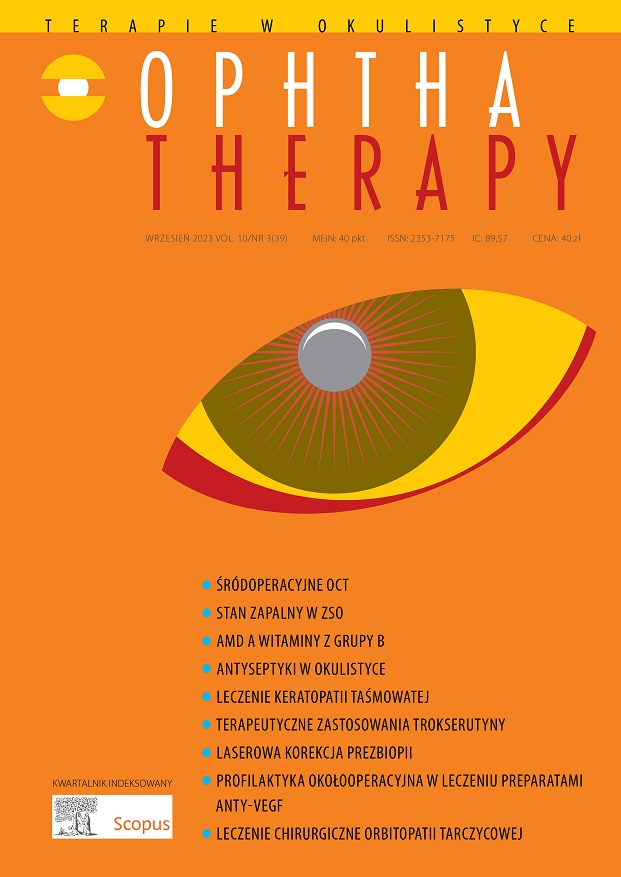The impact of inflammatory flares in dry eye disease Review article
Main Article Content
Abstract
Dry eye disease is a condition treated commonly by most of the ophthalmologists. The current understanding of the disease puts impact on its newly discovered components ? ?flares?. Flares are defined as exacerbations of dry eye disease. They take place in response to the triggers, which may be environmental or internal factors. During the ?flare? the immunological response is being activated and the patients experience the worsening of the symptoms. The introduction of the anti-inflammatory treatment (e.g. topical hydrocortisone solution) is the effective treatment in the cases of inflammatory state exacerbations.
Downloads
Article Details

This work is licensed under a Creative Commons Attribution-NonCommercial-NoDerivatives 4.0 International License.
Copyright: © Medical Education sp. z o.o. License allowing third parties to copy and redistribute the material in any medium or format and to remix, transform, and build upon the material, provided the original work is properly cited and states its license.
Address reprint requests to: Medical Education, Marcin Kuźma (marcin.kuzma@mededu.pl)
References
2. Tsubota K, Pflugfelder SC, Liu Z et al. Defining dry eye from a clinical perspective. Int J Mol Sci. 2020; 21. http://doi.org/10.3390/ijms21239271.
3. Pflugfelder SC, de Paiva CS. The pathophysiology of dry eye disease: what we know and future directions for research. Ophthalmology. 2017; 124: S4-s13. http://doi.org/10.1016/j.ophtha.2017.07.010.
4. Bron AJ, de Paiva CS, Chauhan SK et al. TFOS DEWS II pathophysiology report. Ocul Surf. 2017; 15: 438-510. http://doi.org/10.1016/j.jtos.2017.05.011.
5. Zhang X, Qu Y, He X et al. Dry eye management: targeting the ocular surface microenvironment. Int J Mol Sci. 2017; 18(7): 1398. http://doi.org/10.3390/ijms18071398.
6. Yamaguchi T. Inflammatory response in dry eye. Invest Ophthalmol Vis Sci. 2018; 59: DES192-D199. http://doi.org/10.1167/iovs.17-23651.
7.Rolando M, Zierhut M, Barabino S. Should we reconsider the classification of patients with dry eye disease?[published online November 12, 2019]. Ocul Immunol Inflamm. 2019. http://doi.org/10.1080/09273948.2019.1682618.
8. Perez VL, Stern ME, Pflugfelder SC. Inflammatory basis for dry eye disease flares. Exp Eye Res. 2020; 201: 108294. http://doi.org/10.1016/j.exer.2020.108294.
9. Cutolo CA, Barabino S, Bonzano C et al. The use of topical corticosteroids for treatment of dry eye syndrome. Ocul Immunol Inflamm. 2019; 27(2): 266-75. http://doi.org/10.1080/09273948.2017.1341988.
10. Haber SL, Benson V, Buckway CJ et al. Lifitegrast: a novel drug for patients with dry eye disease. Ther Adv Ophthalmol. 2019; 11: 2515841419870366. http://doi.org/10.1177/2515841419870366.
11. Hamard H, Schmitt C, Plazonnet B et al. Study of the ocular penetration of dexamethasone. [Etude de la pénétration oculaire de la déxamethasone.] In: Demailly P, Hamard H, Luton JP (ed). Oeil et cortisone. Masson, Paris 1975: 33-84.
12. McGhee CN. Pharmacokinetics of ophthalmic corticosteroids. Br J Ophthalmol. 1992; 76(11): 681-4. http://doi.org/10.1136/bjo.76.11.681.
13. Kallab M, Szegedi S, Hommer N et al. Topical Low Dose Preservative-Free Hydrocortisone Reduces Signs and Symptoms in Patients with Chronic Dry Eye: A Randomized Clinical Trial. Adv Ther. 2020; 37(1): 329-41. http://doi.org/10.1007/s12325-019-01137-8.
14.Kuzmanović Elabjer B, Marković L, Bjeloš M et al. A Retrospective Data Review Confirms That Topical Preservative-Free Hydrocortisone Improves Inflammation in Dry Eye Disease. Clin Ophthalmol. 2020; 14: 3691-7. http://doi.org/10.2147/OPTH.S283655.
15. Filippelli M, dell?Omo R, Gelso A et al. Effects of topical low-dose preservative-free hydrocortisone on intraocular pressure in patients affected by ocular surface disease with and without glaucoma. Graefes Arch Clin Exp Ophthalmol. 2022; 260(1): 247-53.

